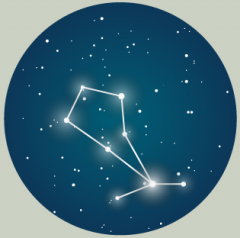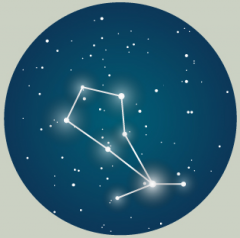![]()
![]()
![]()
Use LEFT and RIGHT arrow keys to navigate between flashcards;
Use UP and DOWN arrow keys to flip the card;
H to show hint;
A reads text to speech;
25 Cards in this Set
- Front
- Back
- 3rd side (hint)
|
The planet with the hottest surface temperature is...?
|
Venus.
|
|
|
|
Which planet has an atmosphere of mostly nitrogen?
|
Earth.
|
|
|
|
True or False: Both moons of Mars are most likely captured objects.
|
True.
|
|
|
|
How do the sizes of Earth, Venus, and Mars compare?
|
Earth is slightly larger than Venus and much larger than Mars.
|
|
|
|
True or False: A planet that spins very rapidly would probably be Terrestrial.
|
False; One of the characteristics of Terrestrial planets is that they have relatively slow rotation periods.
|
|
|
|
What protects Earth from harmful radiation from the Sun?
|
Our strong magnetic field.
|
|
|

What is the name of this constellation?
|
Boötes.
|
|
|
|
What are the two types of planets?
|
Jovian and Terrestrial.
|
|
|
|
When is Mercury most visible in the night sky?
|
At most, two hours before sunrise or after sunset.
|
|
|
|
True or False: During a lunar eclipse, the Moon is located between Earth and the Sun.
|
False; During a lunar eclipse, the Moon moves into Earth’s shadow. This means that Earth must be between the Sun and the Moon. A solar eclipse occurs when Earth moves into the Moon’s shadow. This is what could occur when the Moon is between Earth and the Sun.
|
|
|
|
The Greenhouse Effect dominates what planet?
|
Venus.
|
|
|
|
True or False: The atmosphere of Mars is composed primarily of nitrogen.
|
False; The atmosphere of Mars is composed primarily of carbon dioxide.
|
|
|
|
A moon that is full will appear at its highest point in the sky at what time of the night or day?
|
Midnight.
|
|
|
|
True or False: A planet located 9 AU from the Sun would probably be Jovian.
|
True; One of the characteristics of Jovian planets is that they are located relatively far from the Sun.
|
|
|

What is the name of this constellation?
|
Hercules.
|
|
|
|
What phase of the moon is where the Moon is between Earth and the Sun?
|
New Moon.
|
|
|
|
What phase of the moon is where Earth is between the Moon and the Sun?
|
Full Moon.
|
|
|
|
What phase of the moon is where a thin sliver of the Moon is visible?
|
Crescent.
|
|
|
|
What phase of the moon is where this phase occurs halfway between full and new moon?
|
Last Quarter.
|
|
|
|
What phase of the moon is where most, but not all, of the Moon’s face is illuminated?
|
Gibbous.
|
|
|
|
What planet closely resembles Earth's Moon?
|
Mercury.
|
|
|

What is the name of the bright star in this constellation?
|
Arcturus.
|
Constellation: Bootes |
|
|
What happened to water on Venus?
|
It evaporated and was lost to space.
|
|
|
|
Which of the following is not a way in which the Terrestrial and Jovian planets differ?
A. The Terrestrial worlds have few or no moons, while the Jovian worlds have many moons. B. The Terrestrial planets rotate much slower than Jovian planets. C. The Jovian planets have higher temperatures than Terrestrial planets do. D. The Terrestrial worlds are small and dense, while the Jovian worlds are large and gaseous. E. The orbits of the Terrestrial worlds are relatively close together, while the orbits of the Jovian worlds are far apart. |
C. The Jovian planets have higher temperatures than Terrestrial planets do.
|
|
|
|
What happened to water on Mars?
|
It is frozen in the soil.
|
|

